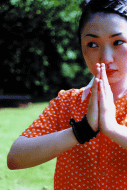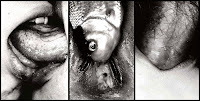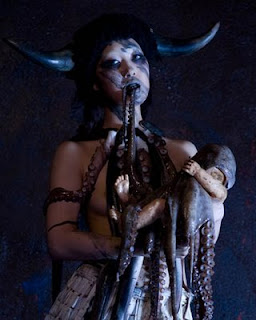Off and on since the beginning of the summer I've been reading Narrow Road to the Interior and Other Writings, a collection of works by Japan's most famous poet, Matsuo Bashō (松尾 芭蕉), translated by Sam Hamill in 1998 and published by Shambhala Press in 2000. I must admit up front that I began the book looking for pure escapism into natural aestheticism and pithy Zen philosophy. I have also my entire life longed to travel through the countryside on foot; the appeal of Bashō's travel writing, or haibun ( 俳文 a traditional form of literature combining travel narrative and haiku), was obvious. As such, I had more or less written the book off as irrelevant to the modern era until the very end, when I reconsidered the haiku on their own terms, this after reading the Afterword, which chronicles the poet's final years as a moody, sometimes misanthropic old man.
Bashō, real name Matsuo Kinsaku (松尾 金作, his pen name was adopted from a shelter a group of his disciples built from plantain trees, 'bashō 芭蕉' in Japanese), is well known for raising the haiku to an art form in its own right. Before, it mostly served to introduce longer pieces of collaborative poetry known as renga (連歌). As it came to stand alone as a form of art all to itself, it perfected certain attributes that came to be known worldwide. Its form is simple, yet highly refined: it must be exactly three lines amounting to seventeen morae (five in the first and third lines, seven in the second), and it must contain a kigo (季語 a seasonal reference word or phrase) and a kireiji (切れ字), literally a "cutting word", sometimes defined as the "ahh effect" in haiku. There is no straightforward translation into English of this latter pivotal word; it is often translated as a dash. The most famous of Bashō's haiku, perhaps the most famous haiku ever, illustrates these themes perfectly:
At the ancient pond
a frog plunges into
the sound of water
As his fame spread, Bashō attained something of a cult status, drawing followers from across
Perhaps written form (translated written form, at that) is an improper medium for relaying the grand beauty of 17th century
**********************************************************
What leaves a stronger impression, for me at least, are the haiku themselves. Those incorporated into the haibun are often bound to the scenes in which they were composed and have only limited relevance when taken alone. However, after the travel writings, Hamill provides translations of some 80-odd pages of poetry with the Japanese provided (but sadly only in romanization). It was reading through these that Bashō really came alive for me.
Essentially, the haiku presented can be broadly categorized into two types: the spring and flower themed, and the autumn/winter water themed. Of course, unabashedly sticking to those that spoke to me personally, I favored the latter. That is not to say the more upbeat, rejuvenatory haiku I dismissed, but it is the solitude and pensiveness, the depressive, yet celebratory, part of the poet's personality that really shines through. We can imagine that many of these were written when the gates of his compound were sealed tight, visitors strictly verboten, as only a few of those I have collected make even the slightest reference to another human being, as in this poem, a casual, yet elegantly precise, snapshot of femininity:
Wrapping dumplings in
bamboo leaves, with one finger,
she tidies her hair
On the other hand, some are just as notable for their deep irreverence, for example:
A rolling cloud—like
a dog pissing on the run—
dense winter showers
O bush warblers!
Now you’ve shit all over
my rice cake on the porch
The most amazing thing about Bashō’s life is the combination of a wealth of knowledge about antiquity, poetry, Daoism, Zen and other intellectual topics, balanced by a tranquil appreciation of such small mundane pleasures and beauties, like the scene depicted above. Surely, one gains something new with every reading. Metaphor is heavy, and sometimes culture-specific, as in the following haiku, where the combination of mist and clouds is reminiscent of sexual desire, but is here used also to draw attention to the fertility of the autumnal fields:
Under the harvest moon,
fog rolling down from foothills,
mist and clouds in the fields
Nonetheless, no matter on what level the reader follows Bashō's verse, the superficial or the profound, it will be done so with supreme pleasure and satisfaction. The following are those haiku, from the translation by Sam Hammil, that I personally found most enjoyable.
not a single soul -- only
autumn evening
the orange blossoms also
have tea’s odor
A snowy evening—
sitting alone with dried salmon,
enjoying chewing
crawling up my leg while I soak
my feet in springwater.
Drunk from my hands,
icy spring water surprises
my aching teeth
At the poor mountain temple,
the iron pot sounds like weeping
in the cold
For today only,
we’ll grow old together in
the first winter rain
Awakened at midnight
by the sound of the rice jar
cracking from the ice
Drawing purifying
water—like the monks’ footsteps,
so clear and so cool
Seas slowly darken
and the wild duck’s plaintive cry
grows faintly white
With clear melting dew,
I’d try to wash away the dust
of this floating world
In the fish market,
from among the little shrimps,
a cricket sings
Drinking sake
brings on insomnia—
it snowed all night
Now autumn begins,
the sea and all the fields
the same shade of green
The moon disappears
into darkening treetops
collecting the rain
Long conversations
beside blooming irises—
joys of life on the road
From every direction
cherry blossom petals blow
into Lake Biwa
blown by winds, pours raindrops
into the bucket
Seen in bright daylight,
its neck is burning red,
this little firefly!
Intermittent rain—
no need at all to worry
over rice seedlings
Delight, then sorrow
afterward—aboard the
cormorant fishing boat
Nothing in the cry
of cicadas suggests they
are about to die
The bright harvest moon
keeps me walking all night long
around the pond
and this evening, the full moon
of November
On a bare branch,
a solitary crow—
autumn evening
Buried under moss
and ivy leaves, but from within
the tomb, a faint prayer
Falling willow leaves—
my master and I and
tolling temple bells
Hearing they eat snakes,
it’s unnerving to listen
to the pheasant’s cry
and the birds cry out—tears
in the eyes of fishes
a spirited monk and
a flirtatious wife
Old lazy-bones—
slowly roused from a nap by
falling spring rain
After morning snow
onion shoots rise in the garden
like little signposts
A new spring begins
the same old wealth—about
two quarts of rice
On New Year’s Day,
each thought a loneliness as
autumn dusk descends
The new year’s first snow—
how lucky to remain alone
at my hermitage





















